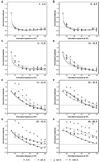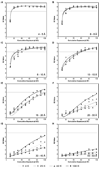Radiation damage effects at four specimen temperatures from 4 to 100 K
- PMID: 19903530
- PMCID: PMC2826528
- DOI: 10.1016/j.jsb.2009.11.001
Radiation damage effects at four specimen temperatures from 4 to 100 K
Abstract
Radiation damage is the primary factor that limits resolution in electron cryo-microscopy (cryo-EM) of frozen-hydrated biological samples. Negative effects of radiation damage are attenuated by cooling specimens to cryogenic temperatures using liquid nitrogen or liquid helium. We have examined the relationship between specimen temperature and radiation damage across a broad spectrum of resolution by analyzing images of frozen-hydrated catalase crystal at four specimen temperatures: 4, 25, 42, and 100K. For each temperature, "exposure series" were collected consisting of consecutive images of the same area of sample, each with 10 e(-)/A(2) exposure per image. Radiation damage effects were evaluated by examining the correlation between cumulative exposure and normalized amplitudes or IQ values of Bragg peaks across a broad range of resolution (4.0-173.5A). Results indicate that for sub-nanometer resolution, liquid nitrogen specimen temperature (100K) provides the most consistent high-quality data while yielding statistically equivalent protection from radiation damage compared to the three lower temperatures. At lower resolution, suitable for tomography, intermediate temperatures (25 or 42K) may provide a modest improvement in cryo-protection without introducing deleterious effects evident at 4 K.
(c) 2009 Elsevier Inc. All rights reserved.
Figures








Similar articles
-
Obtaining high-resolution images of biological macromolecules by using a cryo-electron microscope with a liquid-helium cooled stage.Micron. 2011 Feb;42(2):100-6. doi: 10.1016/j.micron.2010.08.006. Epub 2010 Sep 8. Micron. 2011. PMID: 20869255 Review.
-
Radiation damage in electron cryomicroscopy.Methods Enzymol. 2010;481:371-88. doi: 10.1016/S0076-6879(10)81015-8. Methods Enzymol. 2010. PMID: 20887865
-
The resolution dependence of optimal exposures in liquid nitrogen temperature electron cryomicroscopy of catalase crystals.J Struct Biol. 2010 Mar;169(3):431-7. doi: 10.1016/j.jsb.2009.11.014. Epub 2009 Dec 1. J Struct Biol. 2010. PMID: 19958834
-
A comparison of liquid nitrogen and liquid helium as cryogens for electron cryotomography.J Struct Biol. 2006 Mar;153(3):231-40. doi: 10.1016/j.jsb.2005.12.004. Epub 2006 Jan 4. J Struct Biol. 2006. PMID: 16427786
-
Radiation damage relative to transmission electron microscopy of biological specimens at low temperature: a review.J Microsc. 1978 Jan;112(1):127-38. doi: 10.1111/j.1365-2818.1978.tb01160.x. J Microsc. 1978. PMID: 347079 Review.
Cited by
-
Reconstructing virus structures from nanometer to near-atomic resolutions with cryo-electron microscopy and tomography.Adv Exp Med Biol. 2012;726:49-90. doi: 10.1007/978-1-4614-0980-9_4. Adv Exp Med Biol. 2012. PMID: 22297510 Free PMC article. Review.
-
Accurate model annotation of a near-atomic resolution cryo-EM map.Proc Natl Acad Sci U S A. 2017 Mar 21;114(12):3103-3108. doi: 10.1073/pnas.1621152114. Epub 2017 Mar 7. Proc Natl Acad Sci U S A. 2017. PMID: 28270620 Free PMC article.
-
Investigation of Soft Matter Nanomechanics by Atomic Force Microscopy and Optical Tweezers: A Comprehensive Review.Nanomaterials (Basel). 2023 Mar 7;13(6):963. doi: 10.3390/nano13060963. Nanomaterials (Basel). 2023. PMID: 36985857 Free PMC article. Review.
-
Cryomicroscopy in situ: what is the smallest molecule that can be directly identified without labels in a cell?Faraday Discuss. 2022 Nov 8;240(0):277-302. doi: 10.1039/d2fd00076h. Faraday Discuss. 2022. PMID: 35913392 Free PMC article.
-
A comparative study of single-particle cryo-EM with liquid-nitrogen and liquid-helium cooling.IUCrJ. 2019 Oct 22;6(Pt 6):1099-1105. doi: 10.1107/S2052252519011503. eCollection 2019 Nov 1. IUCrJ. 2019. PMID: 31709065 Free PMC article.
References
-
- Ludtke SJ, Baker ML, Chen DH, Song JL, Chuang DT, Chiu W. De novo backbone trace of groel from single particle electron cryomicroscopy. Structure. 2008;16:441–448. - PubMed
-
- Jiang W, Baker ML, Jakana J, Weigele PR, King J, Chiu W. Backbone structure of the infectious ε15 virus capsid revealed by electron cryomicroscopy. Nature. 2008;451:1130–1134. - PubMed
Publication types
MeSH terms
Substances
Grants and funding
LinkOut - more resources
Full Text Sources

